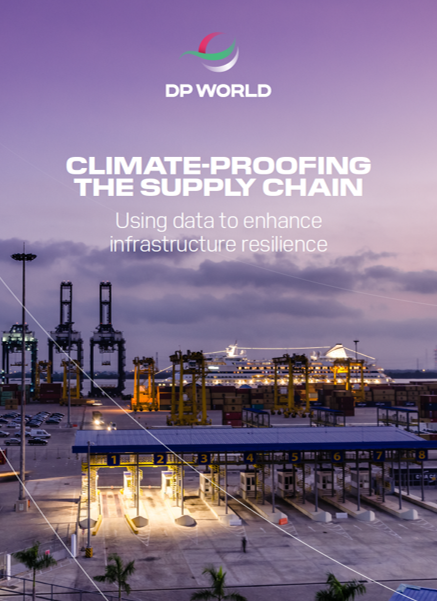
Global climate change is not a future issue; it’s a present reality reshaping our world. In 2022 alone, over $81 billion worth of global trade and at least $122 billion of economic activity were threatened by extreme weather disruptions at ports and terminals. As climate volatility increases, the international supply chain must adapt to mitigate risks.
A leader in the logistics industry, DP World has launched an innovative initiative to bolster climate resilience across its global operations.
The company’s white paper, “Climate Proofing the Supply Chain,” highlights the urgent need for robust climate adaptation measures while also showcasing how forward-thinking approaches can mitigate the risks of climate change, ensuring sustainable trade practices that contribute to a healthier planet.
The paper leverages data from the company’s “Global Asset Resilience Study,” which outlines a new path for climate adaptation in global trade.
“This paper highlights how, if equipped with a mosaic of data, the logistics industry and wider trade community (including governments) will be able to demonstrate a practicable pathway to achieving collective climate resiliency – one that considers the socio-economic consequences and societal vulnerabilities that are routinely under researched and overlooked.”
Download Climate Proofing the Supply Chain
The Climate Imperative for Global Trade
According to the Intergovernmental Panel on Climate Change (IPCC), trade is particularly vulnerable to the impacts of climate change due to its reliance on intricate global networks of ports, terminals, shipping, and ancillary infrastructure. Climate-induced disruptions such as flooding, heat waves, and tropical storms affect not only port infrastructure but also the broader logistics and supply chain ecosystem. This systemic vulnerability demands proactive adaptation measures.
DP World’s Global Asset Resilience Study: A Framework for Climate Adaptation
DP World’s Global Asset Resilience Study aims to fortify climate resilience across its operations by assessing vulnerabilities at 50 selected ports and terminals. Collaborating with Guidehouse and Jupiter Intelligence, DP World used cutting-edge climate risk analytics to evaluate the exposure of its ports to six primary hazards: flooding, precipitation, wind, heat, cold, and hail.
Assessing climate change risk for a port requires an understanding of:
- Hazards: what climate hazards are likely to occur in the port?
- Exposure: what assets and operations are exposed?
- Vulnerability: when will hazards do damage and/or disrupt operations?
The study’s findings revealed that while DP World’s operations are generally resilient to climate risks, seven ports, including Paramaribo, Dakar, Limassol, Santos, Yarimca, Mundra, and Paita, are expected to experience increased downtime by 2050 and beyond. This underscores the importance of early intervention and proactive adaptation measures.
Key Insights from the Study
Direct Climate Risks
The study identified wind, cold, and flooding as the most significant direct risks facing DP World’s port operations. While cold-related risks are expected to decrease, flooding and heat risks are projected to increase significantly by 2100.
Indirect Climate Risks
Indirect risks, including disruptions to ancillary infrastructure and community health impacts, remain under-researched but are critical for comprehensive resilience. For example, the reliance on government-maintained roadways, energy grids, and hinterland connectivity can exacerbate port disruptions when these systems fail due to extreme weather.
Vulnerable Communities and Workforce
Climate change disproportionately affects marginalized workers in emerging markets. Heat stress, water contamination, and loss of livelihoods due to extreme weather can exacerbate economic vulnerabilities, leading to climate-induced migration and social unrest.
Toward a Data-Driven Climate Resilience Framework
Recognizing the interconnectedness of global trade, DP World advocates for a comprehensive, data-driven climate resilience framework that involves both direct and indirect risks. This framework includes:
Governance and Accountability
Effective governance promotes accountability through robust corporate reporting frameworks and national directives. The EU’s Corporate Sustainability Reporting Directive (CSRD) offers a model for harmonizing public and private sector climate resilience strategies.
Capacity Building and Mobilization
Building climate resilience requires collaboration across borders and sectors. The “Short Term Adaptation for Long Term Resilience to Climate Change” (STAR2Cs) program exemplifies how multi-stakeholder partnerships can facilitate adaptive planning and capacity building.
Adaptation and Collective Responsibility
Adaptation must extend beyond individual ports to include the entire trade network. The study advocates for collaborative resilience strategies that encompass ancillary infrastructure and socio-economic vulnerabilities.
Conclusion: Paving the Way for Climate-Proof Global Trade
DP World’s Global Asset Resilience Study exemplifies a proactive, data-driven approach to climate adaptation in global trade. By leveraging advanced climate modeling and risk analytics, the company has set a new standard for climate resilience, highlighting the need for transparency and collaboration. Only through coordinated, cross-sectoral efforts can the global supply chain weather the challenges of a changing climate. The question is not whether trade can adapt, but how quickly it can mobilize collective action for a climate-proof future.
Download Climate Proofing the Supply Chain
Call to Action
Industry peers, government partners, and civil society must rally behind a unified vision for climate resilience. By pooling resources and sharing data, the global trade community can safeguard operations, protect communities, and ensure long-term economic prosperity.
###

